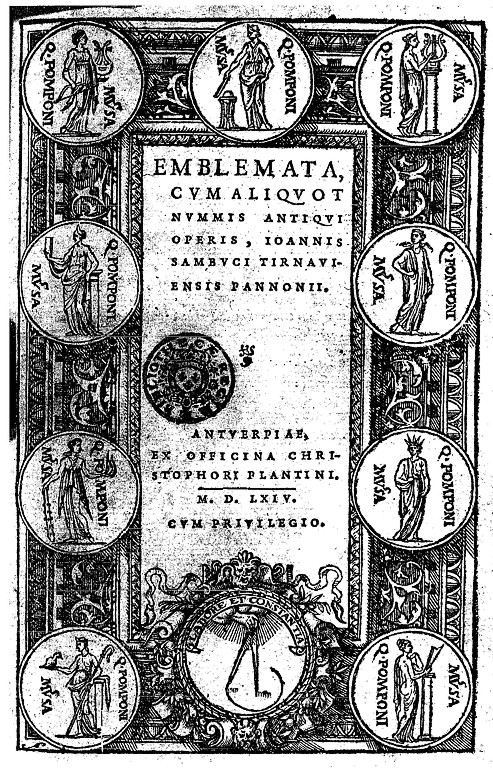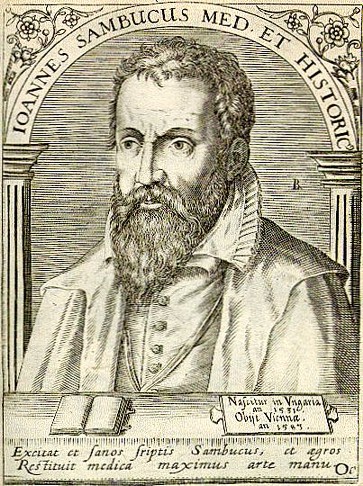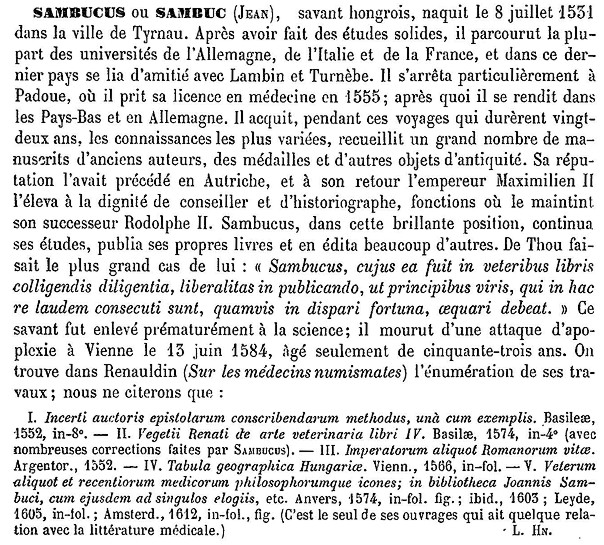Lessico
Ioannes Sambucus
János Zsámboky
Ioannes
Sambucus
in Icones
veterum aliquot ac recentium Medicorum Philosophorumque - 1574
Ioannes Sambucus: nome latino umanistico del medico e poligrafo János Zsámboky
(Nagyszombat, odierna Trnava, 1531 - Vienna 1584). Studiò a Wittenberg, Ingolstadt, Strasburgo, Parigi
e Padova (1553-57), poi fu storiografo ufficiale, medico e bibliotecario alla
corte viennese. Figura eminente dell'umanesimo ungherese (ma fu probabilmente
di nazionalità slovacca), collezionista di codici latini e greci, in rapporto
con l'ambiente italiano (fu amico di Fulvio Orsini![]() , di Pier Vettori e di
altri letterati), pubblicò Emblemata
(1564) e Corpus iuris hungarici
(1581). Si procurò fama di storico d'ispirazione asburgica con la
pubblicazione integrale (1568) delle Rerum
hungaricarum decades di Antonio Bonfini (1427-1505), the egli stesso
aggiornò, sostenendovi la legittimità della successione di Ferdinando
d'Austria sul trono ungherese, contestata dalla nobiltà transilvana e da
Giovanni Szápolyai. Altra opera importante è Icones
veterum aliquot ac recentium Medicorum Philosophorumque (Christophe
Plantin - Antverpiae 1574). Ne è stato edito l'Epistolario
nel 1968.
, di Pier Vettori e di
altri letterati), pubblicò Emblemata
(1564) e Corpus iuris hungarici
(1581). Si procurò fama di storico d'ispirazione asburgica con la
pubblicazione integrale (1568) delle Rerum
hungaricarum decades di Antonio Bonfini (1427-1505), the egli stesso
aggiornò, sostenendovi la legittimità della successione di Ferdinando
d'Austria sul trono ungherese, contestata dalla nobiltà transilvana e da
Giovanni Szápolyai. Altra opera importante è Icones
veterum aliquot ac recentium Medicorum Philosophorumque (Christophe
Plantin - Antverpiae 1574). Ne è stato edito l'Epistolario
nel 1968.



Ioannes
Sambucus
in Bibliotheca chalcographica by Jean-Jacques Boissard - 1652-1669
János Zsámboky or János Zsámboki or János Sámboki, (with his Humanist name Johannes Sambucus or Johannes Pannonicus Sambucus), (Nagyszombat today Trnava, 1531. June 1 – Vienna, 1584. June 13) was a Hungarian humanist scholar: physician, philologist and historian. He was the composer of the most renowned Hungarian Emblemata book: Emblemata cum aliquot nummis antiqui operis, Ioannis Sambuci Tirnaviensis Pannonii (Christophe Plantin - Antverpiae 1564). Sambucus' emblem book was edited five times and it was translated into French and Dutch. He also wrote Icones veterum aliquot ac recentium Medicorum Philosophorumque (Christophe Plantin - Antverpiae 1574).
Portrait of Ioannes Sambucus with his dog Bombo
in the second edition of his Emblemata - 1566
Although
historiae from Pliny to Jerónimo Cortés register many examples of the
faithfulness of dogs, we actually only know a handful of their names. Perhaps
the only one that certainly springs to mind is Argos, the dog of Ulysses. Even
the impeccable Ravisius Textor![]() managed to collect only a dozen of them in
the chapter of "Names of illustrious dogs" of his Cornucopia, in contrast to the following chapter, where he
deluges us with more than fifty names of illustrious horses.
managed to collect only a dozen of them in
the chapter of "Names of illustrious dogs" of his Cornucopia, in contrast to the following chapter, where he
deluges us with more than fifty names of illustrious horses.
This is why it is so peculiar to see that Johannes Sambucus, in the second
edition of his Emblemata, portrays himself with his dog, and furthermore, just
as he bears the identifying inscription "Sambucus at the age of 34, in
the year 1565", so also the dog, looking up at his master with an
ineffably faithful glance, bears an inscription indicating his name:
"Bombo". So peculiar indeed, that Joseph Heller, in his Geschichte
der Holzschneidekunst von den ältesten bis auf die neuesten Zeiten (Bamberg
1823), affirmed this name as the signature of the engraver, thus creating ex
nihilo a hitherto unknown Italian artist.
However, if he had just advanced some pages further, he would have found the bearer of the name in Emblem 126, dedicated by Sambucus to his two dogs Bombo and Madel. (The word "dedication" is perhaps to be taken seriously here, for Sambucus usually dedicates his emblems in a subtitle to friends and patrons, but this one, and the following one – describing the coat of arms of his native town Nagyszombat (Tirnavia), thus in a sense "dedicated" to his town – belong among the few exceptions.) This emblem is a token of the deep friendship that bound Sambucus to his two dogs, those animals that who "followed him on sea and land everywhere"; the pictura also represents them wandering together on earth, while in the background, just sitting in a little boat, the convivial threesome set out on some voyage on the sea.
It is also peculiar that this author's portrait only figures in this second edition (1566). Neither the first edition of 1564, nor the following ones of 1569, 1576 and 1584 – as well as the Dutch and French translations of 1566 and 1567, all published with Plantin – bear it; they all display a more traditional author's bust in an oval frame, and without any companion. Both the format and the date of the 1566 portrait suggest that in this year Sambucus, at the age of thirty-four, returning home after a peregrination of twenty-two years studying all over Europe – the stations of which are mentioned in the emblem quoted – and establishing himself in Vienna as the court physician of Emperor Maximilian, had a portrait painted to commemorate this way of life. And for this portrait he must have considered it important to sit together with the most faithful companion of his life, Bombo. The painted portrait has since then perished, just like the persons represented on it. But the engraved copy has survived to erect a monument to their firm friendship, aere perennius.
Johannes Sambucus né en juin ou juillet 1531 à Tyrnau (Trnava, Nagyszombat),
aujourd'hui situé en République de Slovaquie, et mort le 13 juin 1584 à
Vienne, est un médecin, philologue, humaniste, historien, poète,
collectionneur d'œuvres d'art et mécène hongrois. On trouve également son
nom orthographié : Johann Sambucus, Joannes Sambucus, Joannes Bochius, Ioes
Sabucus, Sambuci, Zsámboki, Iehan Sambucus, Ján Sambucus, Jean Sambucus ,
Johannes Pannonicus Sambucus.
A partir de 1542, il commence des études de philologie à Vienne, puis à
Leipzig, Wittenberg, Ingolstadt, Strasbourg et Paris. Il étudie les langues
anciennes, le droit, l'histoire et la philosophie. Il est particulièrement
influencé par les textes de Platon. En 1551 il devient maître es Philosophie
à l'université de la Sorbonne. De 1558 à 1564 ses voyages le mènent à
Venise, Padoue, Gênes, Naples, Milan, Gand et Anvers. A l'université de
Padoue, il commence des études de médecine, obtient sa licence en 1555 et s'établit
comme médecin à Vienne, qui était alors un centre de la vie scientifique et
culturelle de Hongrie.
C'est au cours de son voyage italien que Sambucus découvre un genre qui fait alors fureur, le livre d'emblèmes. Pour ce poète latiniste féru d'antiquité, c'est la forme idéale pour exprimer son talent poétique et artistique. En 1564 paraît la première édition de ses Emblemata, suivie immédiatement par cinq rééditions qui lui valent une réputation internationale comme maître du genre. C'est le premier écrivain hongrois dont les œuvres sont traduites en français et en anglais.
Dictionnaire encyclopédique
des sciences médicales - 1878
